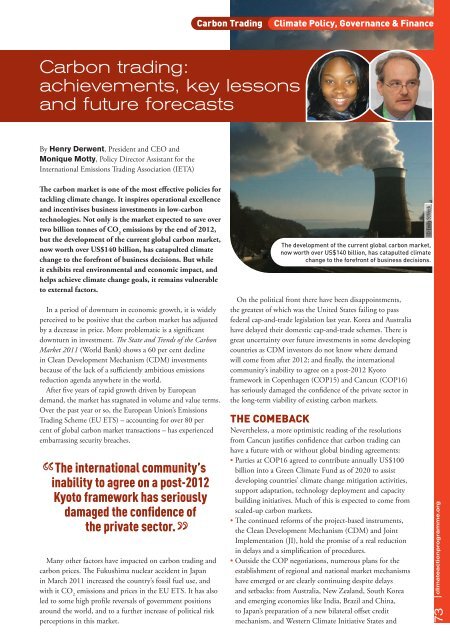Climate Action 2011-2012
You also want an ePaper? Increase the reach of your titles
YUMPU automatically turns print PDFs into web optimized ePapers that Google loves.
carbon Trading<br />
climate Policy, Governance & Finance<br />
Carbon trading:<br />
achievements, key lessons<br />
and future forecasts<br />
By Henry Derwent, President and CEO and<br />
Monique Motty, Policy Director Assistant for the<br />
International Emissions Trading Association (IETA)<br />
The carbon market is one of the most effective policies for<br />
tackling climate change. It inspires operational excellence<br />
and incentivises business investments in low-carbon<br />
technologies. Not only is the market expected to save over<br />
two billion tonnes of CO 2<br />
emissions by the end of <strong>2012</strong>,<br />
but the development of the current global carbon market,<br />
now worth over US$140 billion, has catapulted climate<br />
change to the forefront of business decisions. But while<br />
it exhibits real environmental and economic impact, and<br />
helps achieve climate change goals, it remains vulnerable<br />
to external factors.<br />
In a period of downturn in economic growth, it is widely<br />
perceived to be positive that the carbon market has adjusted<br />
by a decrease in price. More problematic is a significant<br />
downturn in investment. The State and Trends of the Carbon<br />
Market <strong>2011</strong> (World Bank) shows a 60 per cent decline<br />
in Clean Development Mechanism (CDM) investments<br />
because of the lack of a sufficiently ambitious emissions<br />
reduction agenda anywhere in the world.<br />
After five years of rapid growth driven by European<br />
demand, the market has stagnated in volume and value terms.<br />
Over the past year or so, the European Union’s Emissions<br />
Trading Scheme (EU ETS) – accounting for over 80 per<br />
cent of global carbon market transactions – has experienced<br />
embarrassing security breaches.<br />
The international community’s<br />
inability to agree on a post-<strong>2012</strong><br />
Kyoto framework has seriously<br />
damaged the confidence of<br />
the private sector.<br />
Many other factors have impacted on carbon trading and<br />
carbon prices. The Fukushima nuclear accident in Japan<br />
in March <strong>2011</strong> increased the country’s fossil fuel use, and<br />
with it CO 2<br />
emissions and prices in the EU ETS. It has also<br />
led to some high profile reversals of government positions<br />
around the world, and to a further increase of political risk<br />
perceptions in this market.<br />
The development of the current global carbon market,<br />
now worth over US$140 billion, has catapulted climate<br />
change to the forefront of business decisions.<br />
On the political front there have been disappointments,<br />
the greatest of which was the United States failing to pass<br />
federal cap-and-trade legislation last year. Korea and Australia<br />
have delayed their domestic cap-and-trade schemes. There is<br />
great uncertainty over future investments in some developing<br />
countries as CDM investors do not know where demand<br />
will come from after <strong>2012</strong>; and finally, the international<br />
community’s inability to agree on a post-<strong>2012</strong> Kyoto<br />
framework in Copenhagen (COP15) and Cancun (COP16)<br />
has seriously damaged the confidence of the private sector in<br />
the long-term viability of existing carbon markets.<br />
The comeback<br />
Nevertheless, a more optimistic reading of the resolutions<br />
from Cancun justifies confidence that carbon trading can<br />
have a future with or without global binding agreements:<br />
• Parties at COP16 agreed to contribute annually US$100<br />
billion into a Green <strong>Climate</strong> Fund as of 2020 to assist<br />
developing countries’ climate change mitigation activities,<br />
support adaptation, technology deployment and capacity<br />
building initiatives. Much of this is expected to come from<br />
scaled-up carbon markets.<br />
• The continued reforms of the project-based instruments,<br />
the Clean Development Mechanism (CDM) and Joint<br />
Implementation (JI), hold the promise of a real reduction<br />
in delays and a simplification of procedures.<br />
• Outside the COP negotiations, numerous plans for the<br />
establishment of regional and national market mechanisms<br />
have emerged or are clearly continuing despite delays<br />
and setbacks: from Australia, New Zealand, South Korea<br />
and emerging economies like India, Brazil and China,<br />
to Japan’s preparation of a new bilateral offset credit<br />
mechanism, and Western <strong>Climate</strong> Initiative States and<br />
© Emily Schreck<br />
73 climateactionprogramme.org












